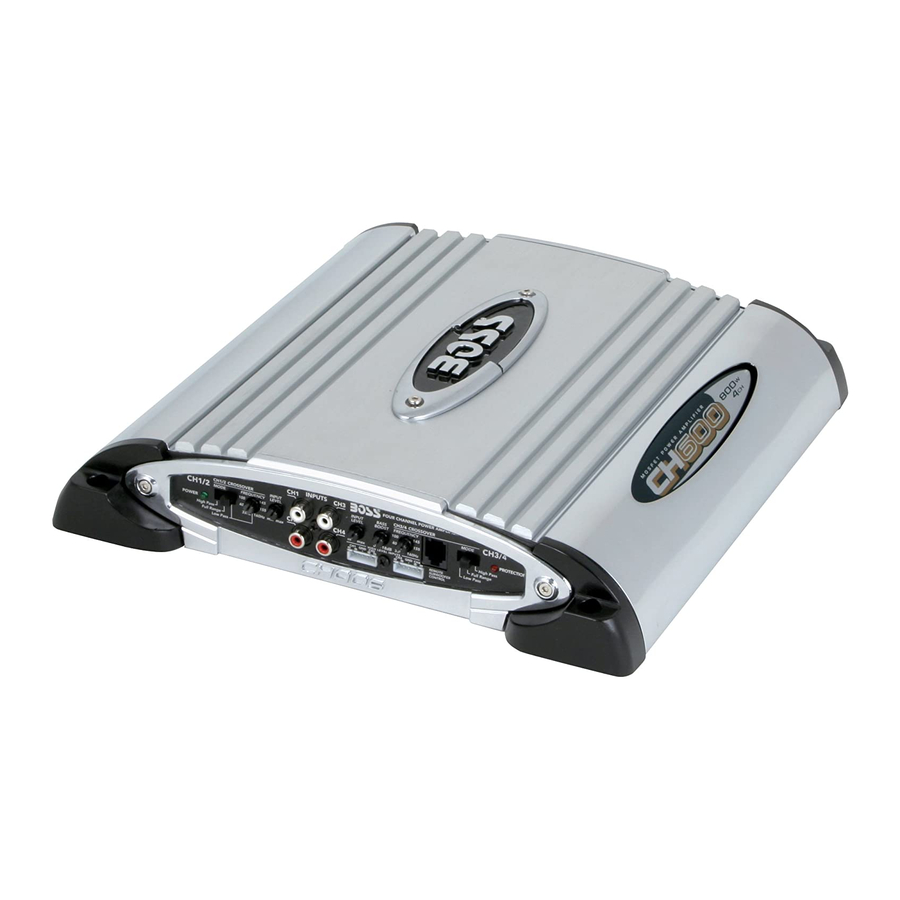Bose Lifestyle SA-3 Théorie du fonctionnement - Page 2
Parcourez en ligne ou téléchargez le pdf Théorie du fonctionnement pour {nom_de_la_catégorie} Bose Lifestyle SA-3. Bose Lifestyle SA-3 4 pages. Bose stereo amplifier owner's guide sa-2, sa-3
Également pour Bose Lifestyle SA-3 : Manuel du propriétaire (32 pages), Manuel (34 pages)

SA-2 and SA-3 Theory of Operation
At full volume the frequency response of the system is basically "flat", over the frequency range from 10 Hz to
15 kHz. At lower volume levels, the dynamic equalizer provides up to 16 dB of bass boost at 50 Hz. A graph of
frequency response vs. volume is shown in Figure 2.
Microcontroller:
Control of the product occurs via a serial data link (BoseLink) from the music center, communicated through
one of the wires of the DIN cable. The microcontroller automatically detects whether it is connected to an
existing (CD-5, CD-20, MRI, AV28) or new (AV18, AV38) music center, by recognizing either the original (1-
way) smart speaker protocol, or newer 2-way smart speaker BoseLink protocol.
In addition to communicating back and forth with the music center, the microcontroller does the following:
Determines power mode (Standby or ON).
Sets volume level and Mute.
Reads DIP switch settings (for room address, etc)
Detects presence of audio at RCA input jacks (on SA-3).
Detects presence of external potentiometer (at J6 input).
Monitors temperature of power supply bridge rectifier
Monitors power supply voltage
Detailed Theory of Operation:
Power Supply:
The primary side of the power supply consists of the fuse in series with triac switch Q1 in series with the
primary coil of the transformer. In parallel with the triac is a large film capacitor (C11 or C27) and resistor (R10)
which provides a small "trickle" current to the transformer when the triac is off (open circuit). This small amount
of current is enough to keep the microcontroller (U4) powered. This mode is called Standby. When an ON
command is received via BoseLink, from the music center, pin 10 of the micro goes to logic high and activates
opto-coupler triac driver U7 which then turns on triac Q1, and the power supply becomes fully energized.
The transformer secondary power supply is comprised of bridge rectifier BR1 and electrolytic filter capacitors
C7 and C10. The voltage for LSA-2 is nominally about 36 VDC, and for LSA-3 it is about 48 VDC. LSA-3 uses
nd
a 2
set of power supply rails from BR2 and electrolytic capacitors C8 and C9 at about 24 VDC. These parts
are not used on LSA-2.
The low voltage electronics are powered by +8 VDC and –8 VDC voltage regulators U8 and U9 (respectively).
For LSA-2 the input of the regulators are connected to the BR1 power supply through diodes D6 and D7. On
LSA-3 these diodes are not used, and the regulators are connected directly to the BR2 supply. In Standby
mode, the +8 VDC and –8 VDC supply rails are turned OFF by transistors Q13 and Q14 respectively. This is to
conserve power and to prevent low voltage poor operation of the input op-amp circuit.
The microcontroller is powered by a 5 VDC regulator (U10). The input of this regulator is connected to the
output of a low drop-out discrete 26 VDC regulator, comprised of transistors Q10, Q11, and Q12. In Standby
mode this voltage is much less, usually between 9 and 16 VDC.
Differential Input Amplifier:
Channel 1 and 2 inputs are applied to unity gain differential amplifier U1. The differential amplifier rejects
common-mode noise that may be picked up on the long DIN cable wires.
11/22/2005
Page 2 of 4
27172X-00
